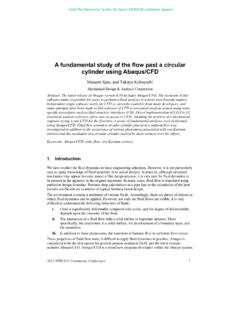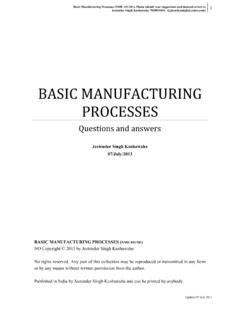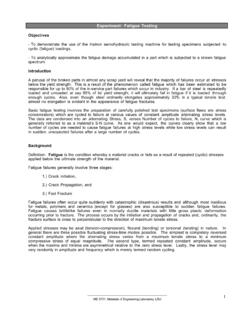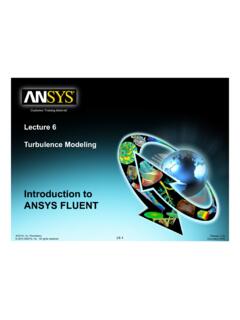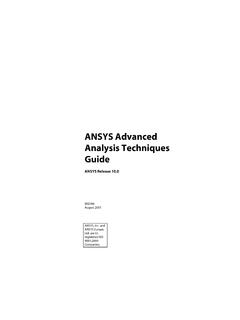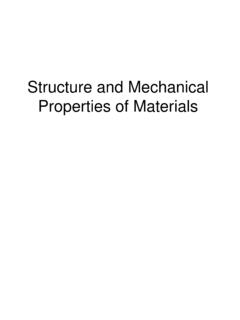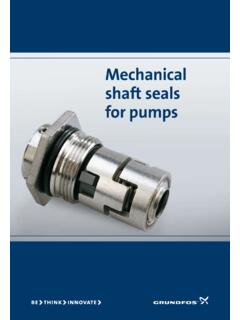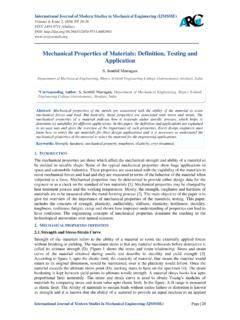Transcription of Experiment: Mechanical Testing- Impact & Hardness Testing
1 2 Experiment: Mechanical Testing - Impact & Hardness TestingObjectiveThe main objective of this experiment is to introduce two important basic Mechanical property tests; Hardness (using Rockwell Testing ) and Impact (using Charpy Testing ). Chauvenet s Criterion will be applied to identifyoutliers and probability paper will be used to ascertain whether or not the repeated measure Hardness data isnormally Mechanical properties of materials are ascertained by performing carefully designed laboratoryexperiments that replicate, as nearly as practical, the service conditions. Factors to be considered includethe nature of the applied load(s), its duration and the applicable environmental conditions.
2 It is possiblefor the load to be tensile, compressive, or shear, and its magnitude may be constant with time, or it mayfluctuate continuously. Application time may be for only a fraction of a second, or it may extend over aperiod of many years. Service temperature can also be an important properties are of concern to a variety of parties ( , producers and material consumers,research organizations and government agencies) that have differing interests. Consequently, it isimperative that there be some consistency in the manner in which tests are conducted, and in theinterpretation of their results. This consistency is accomplished by using standardized Testing and publication of these standards are often coordinated by professional societies.
3 In theUnited States the most active organization is the American Society for Testing and Materials (ASTM); itsAnnual Book of ASTM Standards comprises numerous volumes that are updated yearly. A large numberof the ASTM Standards are relate directly to Mechanical Testing techniques including specifications formeasuring the Hardness and Impact properties of Impact TestingToughness is a measure of the amount of energy a material can absorb before fracturing. It becomes ofengineering importance when the ability of a material to withstand an Impact load without fracturing isconsidered. Impact test conditions were chosen to represent those most severe relative to the potentialfor fracture, namely, (1) deformation at a relatively low temperature, (2) a high strain rate ( , rate ofdeformation), and (3) a triaxial stress state (which may be introduced by the presence of a notch).
4 Two standardized tests, the Charpy and Izod, are commonly used to measure Impact Energy (sometimesreferred to as Notch Toughness). The Charpy V-notch (CVN) technique is most commonly used in theUnited States. For both Charpy and Izod, a V-notch is machined into a bar specimen with a square cross-section. A standard V-notch test apparatus is schematically illustrated in Figure 1. The load is applied asan Impact blow from a weighted pendulum hammer that is released from a cocked position at a fixedheight "h". The specimen is positioned at the base as shown. Upon release, a knife edge mounted onthe pendulum strikes and fractures the specimen at the notch, which acts as a point of stressconcentration for the high velocity Impact blow.
5 The pendulum continues its swing, rising to a maximumheight "h ", which is lower than "h". Based on the difference between h and h , the energy absorption ofthe specimen is computed. The primary difference between the Charpy and Izod techniques lies in themanner of specimen support as is indicated in Figure 4. Variables including specimen size and shape, aswell as notch configuration and depth can influence the test and Barsom (1987) developed a correlation between CVN and Fracture Toughness (KIc) that is givenby:Where KIc is the fracture toughness at slow loading rates (ksi(in)1/2), ys is the offset yield strength(ksi), and CVN is the standard Charpy V-Notch Impact test 1(a) and 1 (b) Schematic Drawing of a Standard Impact - Testing Apparatus.
6 [Callister, 1991]Background - Statistical ConsiderationsChauvenet's CriterionEngineers often find that some data points look bad and out of place in comparison with the bulk of the datain a set of repeated measures data. When this occurs, the engineer must decide if outlying data points areexperimental blunders, and hence may be neglected, or if they represent some new type of physicalphenomenon that is peculiar to a certain operating condition. The engineer cannot just ignore those pointsthat do not fit with expectations, thus Chauvenet developed a criterion to determine whether or not suspectdata points can be eliminated from the analysis (points may be eliminated from the analysis but should neverbe eliminated from the data set!)
7 4 Suppose "n" measurements of a quantity are taken and "n" is large enough that we may expect theresults to follow a Gaussian (Normal) Error Distribution. This distribution may be used to compute theprobability that a given reading will deviate a certain amount from the mean. A probability much smallerthan 1/n is very unlikely to occur in a set of "n" measurements. Chauvenet's criterion specifies that areading may be rejected if the probability of obtaining the particular deviation from the mean is less than1/(2n.). Table 1 lists values of the ratio of mean deviation to standard deviation for various values of "n"according to this applying Chauvenet's criterion to consider the elimination of suspect data points, one first calculatesthe mean value and standard deviation using all of the collected data points.
8 The deviations of theindividual points from the mean are then compared with the standard deviation in accordance with theinformation in Table 3. If the critical value is exceeded then the data points in question are eliminatedfrom the analysis. For the final data presentation, a new mean value and standard deviation arecomputed with the rejected data points eliminated. Note that Chauvenet's criterion might be applied asecond or third time to eliminate additional points, but this practice is unacceptable, and only the firstapplication may be 1 - Chavenet's Criterion For Rejecting A ReadingNumber of readings,nRatio of maximum acceptable mean deviation tostandard deviation, dmax/ , Distribution Probability PaperTo determine whether a data set follows a Gaussian distribution, Probability Paper is often Paper uses the coordinate system where the ordinate (Y axis) has the percent of readings at orbelow the value of the abscissa (X axis)
9 Which is the value of a particular reading. The data must be Rank-Ordered prior to plotting and the largest value cannot be plotted because the Y-axis does not extend to100%. The X-axis spacings are such that Normally Distributed Data (Gaussian) will plot as a straight line; thusif the plotted data is approximately linear when plotted on probability paper, then the data can be said to benormally distributed. The upper and lower ends of the curve are less important than the center portion indetermining the adequacy of the Normally Distributed 1: The following length data were collected for the measurement of the length of a single steel Chauvenet's Criterion to determine if suspect data points can be eliminated, plot the data onprobability paper, and comment on the normality of the , mean of the data set is given by:Sample standard deviation can be computed as:The following table presents the data in Rank Order, the Mean Deviations (di) and the ratio of the meandeviations to the standard deviation.
10 Rank OrderXi (cm)|di||di|/sChauvenet s "DO NOT ELIMINATE THE DATA POINT FROM THE DATA SHEET"!!!Since dmax / S for the ten readings is (see Table 1), the first data point can be eliminated from the dataanalysis, but to determine whether or not the data is Normally (Gaussian) Distributed, the data should now betabulated in rank order with appropriate cumulative percentages and the rejected data points not included:(*Since there are now only 9 data points, the % Below Xi will be in increments of 1/9 X 100 or )6 Rank OrderXi (cm)% Below data are now plotted on Probability Paper as shown below to evaluate the Normality of the mean value of the revised data set, without the Chauvenet rejected data points included, shouldnow be computed.
